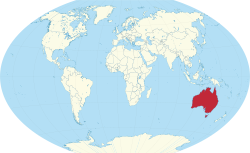Biology:Nymphaea kimberleyensis
| Nymphaea kimberleyensis | |
|---|---|
| Scientific classification | |
| Kingdom: | Plantae |
| Clade: | Tracheophytes |
| Clade: | Angiosperms |
| Order: | Nymphaeales |
| Family: | Nymphaeaceae |
| Genus: | Nymphaea |
| Species: | N. kimberleyensis
|
| Binomial name | |
| Nymphaea kimberleyensis (S.W.L.Jacobs) S.W.L.Jacobs & Hellq.[1]
| |

| |
| Nymphaea kimberleyensis is endemic to Western Australia[1] | |
| Synonyms[1] | |
| |
Nymphaea kimberleyensis is a species of waterlily endemic to Western Australia.[1]
Description
Vegetative characteristics
Nymphaea kimberleyensis has swollen, 12 cm long rhizomes. The leaves have a dentate margin.[2]
Generative characteristics
The sepals are 9–18.5 cm long. The 9.5-14.5 cm long petals[3] are blue, but display white colouration at the base. The androecium consists of 200 stamens. The gynoecium consists of 15-20 carpels. The glabrous seeds have only been observed in an immature state.[2] The fruit does not develop to maturity.[3]
Reproduction
Generative reproduction
Flowering occurs from March to June. Only immature seeds have been observed.[2] The fruit fails to reach full maturity.[3]
Taxonomy
Publication
It was first described by Surrey Wilfrid Laurance Jacobs as Nymphaea immutabilis subsp. kimberleyensis S.W.L.Jacobs in 1992 . Later, it was elevated to a separate species Nymphaea kimberleyensis (S.W.L.Jacobs) S.W.L.Jacobs & Hellq. by Surrey Wilfrid Laurance Jacobs and Carl Barre Hellquist in 2011.[1]
Type specimen
The type specimen was collected by S. Jacobs, and P. Wilson in the Kimberly region of Western Australia on the 23rd of May 1988.[2][3]
Placement within Nymphaea
It is placed in Nymphaea subgenus Anecphya.[3][4][5]
Natural hybridisation
Nymphaea kimberleyensis may be of hybrid origin.[3]
Etymology
The specific epithet kimberleyensis indicates this species origin in Kimberly, Australia.[6][7]
Conservation
It is a rare species.[2]
Ecology
Habitat
It is found in small water courses with less intense flows,[8] and in a lagoon experiencing seasonal droughts.[2]
References
- ↑ 1.0 1.1 1.2 1.3 1.4 "Nymphaea kimberleyensis (S.W.L.Jacobs) S.W.L.Jacobs & Hellq." (in en). Royal Botanic Gardens, Kew. http://www.plantsoftheworldonline.org/taxon/77111424-1. Retrieved 2 January 2024.
- ↑ 2.0 2.1 2.2 2.3 2.4 2.5 Jacobs, S. W. L. (1992). "New species, lectotypes and synonyms of Australasian Nymphaea (Nymphaeaceae)." Telopea, 4(4), 635-641.
- ↑ 3.0 3.1 3.2 3.3 3.4 3.5 Jacobs, S. W., & Hellquist, C. B. (2011). "New species, possible hybrids and intergrades in Australian Nymphaea (Nymphaeaceae) with a key to all species." Telopea, 13(1-2), 233-243.
- ↑ Löhne, C., Borsch, T., Jacobs, S. W., Hellquist, C. B., & Wiersema, J. H. (2008). "Nuclear and plastid DNA sequences reveal complex reticulate patterns in Australian water-lilies (Nymphaea subgenus Anecphya, Nymphaeaceae)." Australian Systematic Botany, 21(4), 229-250.
- ↑ Dalziell, E. L. (2016). "Seed biology and ex situ storage behaviour of Australian Nymphaea (water lilies): implications for conservation (Doctoral dissertation, PhD thesis. University of Western Australia, Perth, WA)."
- ↑ Glossary H – K – The Bible of Botany. (n.d.). Retrieved January 2, 2024, from https://bibleofbotany.com/index/glossary-introduction/glossary-page-4/
- ↑ (2007). K. In: Etymological Dictionary of Grasses. Springer, Berlin, Heidelberg. https://doi.org/10.1007/978-3-540-38434-2_12
- ↑ Pusey, B. J., & Kath, J. (2015). "Environmental water management in the Fitzroy River Valley: information availability, knowledge gaps and research needs." Unpublished report to the Department of Water, Western Australia.
Wikidata ☰ Q17253250 entry
 |

